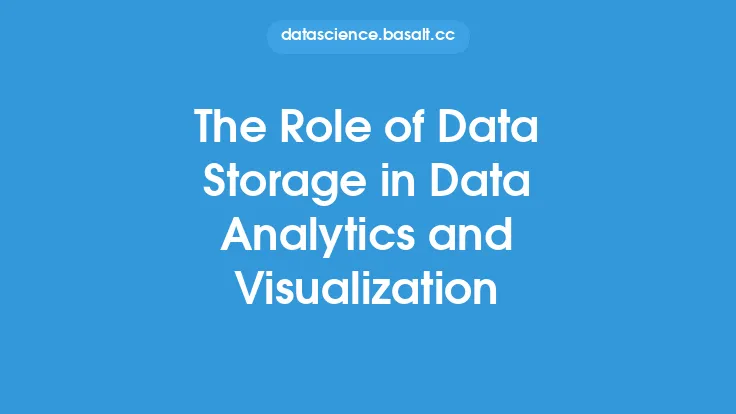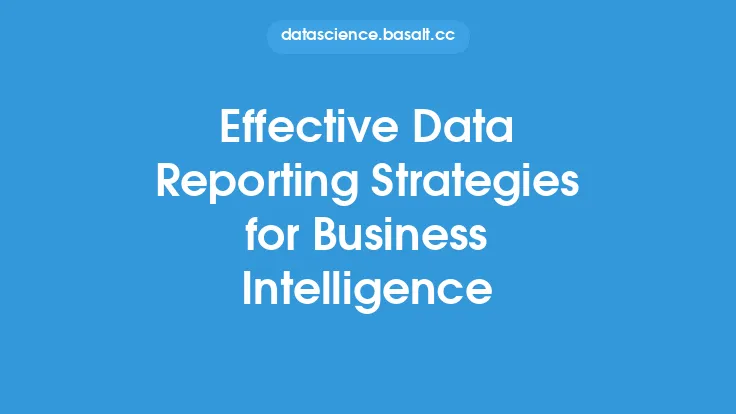As the volume, variety, and velocity of data continue to increase, organizations are faced with the challenge of storing and managing large amounts of data, often referred to as big data. Effective data storage strategies are crucial for big data and analytics, as they enable organizations to extract insights and value from their data. In this article, we will explore the key considerations and strategies for storing big data, including the different types of data storage, data storage architectures, and best practices for data storage management.
Introduction to Data Storage for Big Data
Big data refers to the large amounts of structured, semi-structured, and unstructured data that organizations generate and collect. This data can come from various sources, including social media, sensors, mobile devices, and applications. To store and manage big data, organizations need a scalable and flexible data storage infrastructure that can handle the volume, variety, and velocity of the data. There are several types of data storage, including relational databases, NoSQL databases, data warehouses, and data lakes. Each type of data storage has its own strengths and weaknesses, and the choice of which one to use depends on the specific needs of the organization.
Data Storage Architectures for Big Data
A data storage architecture refers to the overall design and structure of the data storage infrastructure. There are several data storage architectures that are commonly used for big data, including centralized, distributed, and hybrid architectures. A centralized architecture stores all the data in a single location, such as a data warehouse or a relational database. A distributed architecture, on the other hand, stores data across multiple locations, such as a cluster of servers or a cloud-based storage system. A hybrid architecture combines elements of both centralized and distributed architectures, storing some data in a central location and other data in a distributed manner. The choice of data storage architecture depends on the specific needs of the organization, including the volume and variety of the data, as well as the performance and scalability requirements.
Data Storage Technologies for Big Data
There are several data storage technologies that are commonly used for big data, including hard disk drives (HDDs), solid-state drives (SSDs), and flash storage. HDDs are traditional storage devices that use spinning disks and mechanical heads to read and write data. SSDs, on the other hand, use flash memory to store data and are generally faster and more reliable than HDDs. Flash storage is a type of SSD that uses flash memory to store data and is often used in high-performance applications. Other data storage technologies that are used for big data include tape storage, cloud storage, and object storage. Tape storage is a traditional storage technology that uses magnetic tape to store data and is often used for archiving and backup purposes. Cloud storage refers to the use of cloud-based storage services, such as Amazon S3 or Microsoft Azure Blob Storage, to store and manage data. Object storage is a type of storage that stores data as objects, such as files or blobs, and is often used in cloud-based applications.
Best Practices for Data Storage Management
Effective data storage management is critical for big data and analytics, as it enables organizations to extract insights and value from their data. There are several best practices for data storage management, including data classification, data compression, data encryption, and data backup and recovery. Data classification refers to the process of categorizing data based on its sensitivity and importance, and storing it accordingly. Data compression refers to the process of reducing the size of data to improve storage efficiency and reduce costs. Data encryption refers to the process of protecting data from unauthorized access by encrypting it with a password or encryption key. Data backup and recovery refer to the process of creating copies of data and storing them in a separate location, such as a backup tape or a cloud-based storage service, to ensure that data can be recovered in case of a disaster or data loss.
Data Storage Security and Governance
Data storage security and governance are critical for big data and analytics, as they enable organizations to protect their data from unauthorized access and ensure that it is stored and managed in compliance with regulatory requirements. There are several data storage security and governance best practices, including access control, authentication, and auditing. Access control refers to the process of controlling who has access to data and what actions they can perform on it. Authentication refers to the process of verifying the identity of users and ensuring that they have the necessary permissions to access data. Auditing refers to the process of monitoring and logging all access to data, to ensure that it is stored and managed in compliance with regulatory requirements. Other data storage security and governance best practices include data masking, data anonymization, and data retention. Data masking refers to the process of hiding sensitive data, such as credit card numbers or personal identifiable information, to protect it from unauthorized access. Data anonymization refers to the process of removing personally identifiable information from data, to protect the privacy of individuals. Data retention refers to the process of storing data for a specified period, to ensure that it is available for future use and to comply with regulatory requirements.
Data Storage Scalability and Performance
Data storage scalability and performance are critical for big data and analytics, as they enable organizations to store and manage large amounts of data and extract insights and value from it. There are several data storage scalability and performance best practices, including horizontal scaling, vertical scaling, and caching. Horizontal scaling refers to the process of adding more storage devices or nodes to a storage system, to increase its capacity and performance. Vertical scaling refers to the process of increasing the power and capacity of individual storage devices or nodes, to improve performance and reduce costs. Caching refers to the process of storing frequently accessed data in a fast and accessible location, such as a cache layer or a content delivery network, to improve performance and reduce latency. Other data storage scalability and performance best practices include data tiering, data striping, and data mirroring. Data tiering refers to the process of storing data in different tiers, based on its frequency of access and importance, to improve performance and reduce costs. Data striping refers to the process of dividing data into smaller chunks and storing them across multiple devices or nodes, to improve performance and increase capacity. Data mirroring refers to the process of creating duplicate copies of data, to ensure that it is available and accessible in case of a disaster or data loss.
Conclusion
In conclusion, effective data storage strategies are critical for big data and analytics, as they enable organizations to extract insights and value from their data. There are several key considerations and strategies for storing big data, including the different types of data storage, data storage architectures, and best practices for data storage management. By understanding these considerations and strategies, organizations can design and implement a scalable and flexible data storage infrastructure that meets their needs and enables them to achieve their goals. Additionally, by following best practices for data storage security and governance, scalability and performance, organizations can ensure that their data is protected, available, and accessible, and that they can extract insights and value from it.





